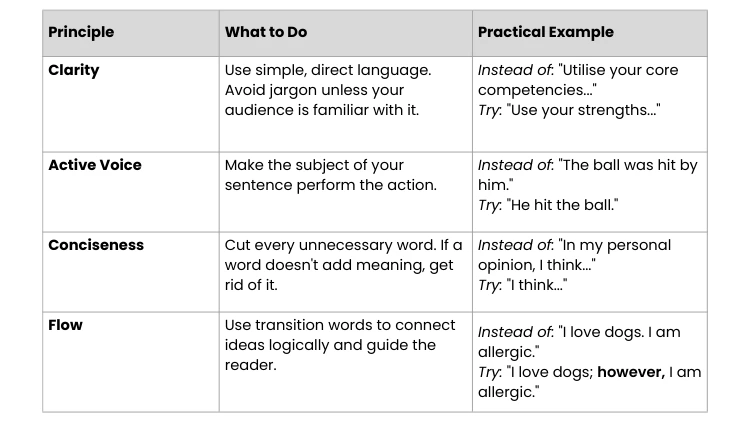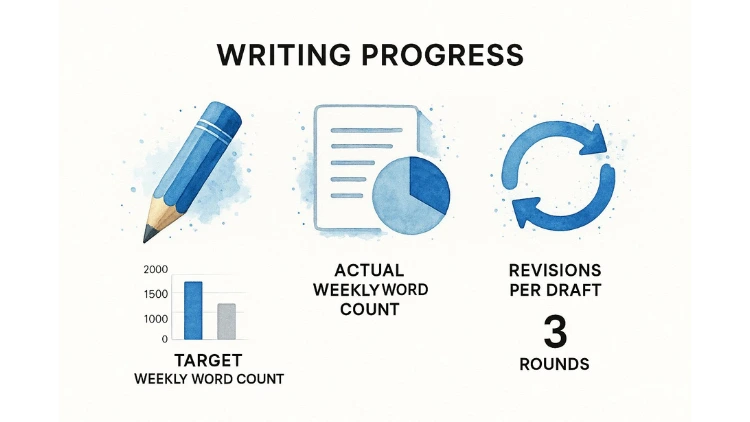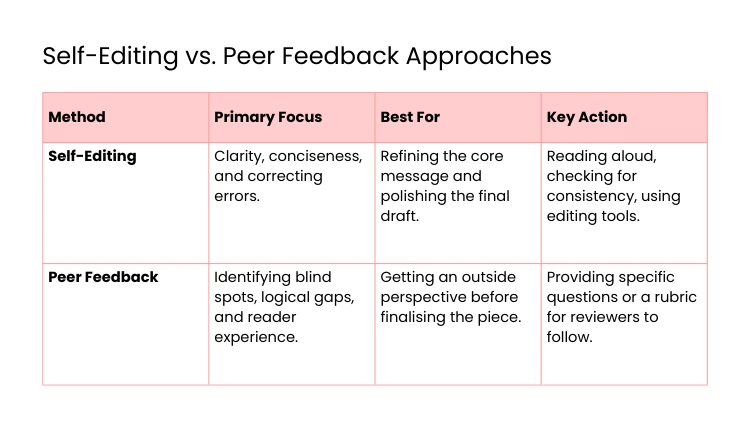How to Improve Writing Skills for Lasting Impact

Before you can write with flair, you have to write with clarity. It all comes back to mastering the fundamentals—things like building strong sentences, using an active voice, and making sure every single word pulls its weight. It's about laying down a solid foundation so your message is impossible to misunderstand.
Jump To Section

Earn As You Learn
Earn 25% commission when your network purchase Uplyrn courses or subscribe to our annual membership. It’s the best thing ever. Next to learning,
of course.
Build a Strong Foundation with Clear Writing
Great writing isn't about flexing a huge vocabulary or constructing complex sentences. It’s simply about clear communication. Before you can think about developing a unique voice or telling a compelling story, your core message has to be crystal clear.
If someone has to reread your sentences just to figure out what you mean, you’ve already lost them.
The real goal is to make your writing feel effortless to read. That process starts at the sentence level. Think of each one as a building block, perfectly shaped to connect to the next. This isn't just for beginners, either; it's a discipline that sharpens the work of even the most seasoned writers.
Prioritise Active Voice for Impact
Want a quick way to make your writing punchier and more direct? Use the active voice. In an active sentence, the subject is the one doing the action, which gives your words more energy and makes them easier to follow. The passive voice, on the other hand, is when the subject is being acted upon.
Let's look at a simple example:
- Passive: The report was written by the marketing team.
- Active: The marketing team wrote the report.
See the difference? The active version is shorter, gets straight to the point, and just feels more confident. While the passive voice has its place—like when you don't know who did the action—aiming to use the active voice 80-90% of the time will dramatically improve your clarity. It forces you to put the important stuff first.
Actionable Insight: To start building this habit, open your last piece of writing and use your word processor's search function (Ctrl+F) to find the word "by". This often flags passive sentences. For each result, ask yourself, "Can I flip this to make the subject do the action?" This simple exercise trains your brain to spot and fix passive voice automatically.
Master Transitions to Guide Your Reader
Think of transition words as signposts. They guide your reader smoothly from one idea to the next. Without them, your writing can feel disjointed and choppy, forcing your reader to do the hard work of connecting the dots themselves.
Proper transitions create a logical flow that makes your writing feel cohesive. A little while back, we saw a piece on privatetutor.sg that mentioned how schools really drill this into students. They teach them to use words like 'therefore' and 'however' to structure their thoughts, which builds a strong foundation for academic writing.
Here’s a practical example of writing without and with transitions:
- Without Transitions: Sales increased last quarter. We hired five new team members. Our marketing budget was cut.
- With Transitions: Sales increased last quarter; as a result, we hired five new team members, despite the fact that our marketing budget was cut.
The second version tells a much clearer story about the relationship between the events.
Here’s a quick breakdown of different types of transitions:
- To Add Information: additionally, furthermore, in addition
- To Show Contrast: however, on the other hand, nevertheless
- To Show Cause and Effect: consequently, therefore, as a result
- To Give an Example: for instance, for example, specifically
Actionable Insight: Don't just pepper these words into your writing for the sake of it. Take a moment to think about the actual relationship between your sentences. Ask yourself: "Does this next point add to, contrast with, or result from what I just said?" Your answer will point you to the perfect transition.
Here’s a quick summary of these core principles and the immediate impact they can have on your writing.
Quick Wins for Foundational Writing Skills
Mastering these skills isn't just about following rules. It’s about respecting your reader’s time and energy. When you focus on clarity and flow, you're not just throwing your ideas out there—you're making sure they're actually understood.
And remember, before you can persuade, inspire, or entertain, you first have to be clear. For more on this, check out our guide on how to always write for your readers. Adopting this mindset will improve every single thing you write from here on out.

Build a Writing Routine That Actually Sticks
Real, lasting improvement in any skill doesn't come from a few heroic, all-night sessions. It's built through consistent, daily effort. The same exact principle applies to becoming a better writer.
So, let's forget the intimidating advice to "write for hours every single day." That’s a surefire way to burn out. Instead, we're going to build a practical, sustainable routine that actually fits into your real life. The goal here isn’t to become a bestselling author overnight; it’s about making writing a regular, manageable habit. Small, repeatable actions create powerful momentum that will transform your skills far more than cramming ever could.

Find Your Golden Hour for Writing
Everyone operates on a unique internal clock. Some of us are bright-eyed at dawn, while others do their best thinking long after the sun has set. Trying to force yourself to write at 6 a.m. when you're a natural night owl is just setting yourself up for failure. The real key is to identify your peak productivity window and guard it fiercely.
Maybe it's that quiet hour before the family wakes up. Or perhaps it's during your lunch break or late in the evening when the day's tasks are finally done.
Actionable Insight: For one week, just pay attention to your energy levels. Keep a simple log on a notepad or in your phone. Every few hours, rate your focus on a scale of 1-5. You’ll quickly spot a pattern that reveals your ideal writing time. Once you find that golden hour, block it out on your calendar. Treat it like an unbreakable appointment with yourself.
Set Goals You Can Actually Achieve
One of the fastest ways to kill a new habit is to set the bar impossibly high. If you’ve never run a marathon, you don’t start by trying to run 42 kilometres on day one. Aiming to write 1,000 words every day right out of the gate is just as overwhelming.
Instead, start with a goal that feels almost too easy.
What about just 250 words a day? That's roughly the length of a short email, making it totally manageable even on your most chaotic days. Hitting that small target gives you a daily win, building the confidence and motivation you need to keep going.
Here's a practical example: A freelance writer we know was really struggling with consistency. She ditched her goal of "write one article per day" and replaced it with "write for 25 minutes without stopping." This tiny shift moved her focus from the output to the process, which made showing up so much easier. Within a month, her daily word count had naturally doubled—without all the pressure.
As you get more consistent, you can slowly nudge the target up. But the magic is in starting with a goal you know you can win.
Carve Out a Distraction-Free Zone
Your environment has a massive impact on your ability to focus. It's nearly impossible to do deep, thoughtful work when your phone is buzzing every two minutes and you have a dozen browser tabs screaming for your attention.
Creating a "distraction-free zone" doesn't mean you need a soundproof home office. You can create one anywhere with a bit of intention.
- Go on a Digital Diet: Use a browser extension to block social media and news sites during your writing time. Better yet, put your phone on silent and move it to another room entirely. Out of sight, out of mind.
- Clear Your Physical Space: A tidy desk often leads to a tidier mind. Take 60 seconds to clear your workspace before you begin.
- Set a Boundary: If you live with others, let them know your writing time is protected. A simple, "Hey, I'm going to be focusing for the next 30 minutes" can make a huge difference.
As you start weaving these strategies into your life, you'll see just how much they help. If you want to dive deeper, you can learn more about the power of routine and how it applies to pretty much any skill you want to build.
Use Prompts to Kickstart Your Engine
Even with the perfect routine, some days the well just feels dry. The blank page can feel like a giant, white wall. This is where writing prompts and freewriting exercises are absolute lifesavers.
Freewriting is as simple as it sounds: set a timer for five or ten minutes and just write. Don't stop, don't edit, and definitely don't judge what comes out. The only rule is to keep your fingers moving. This little trick helps you bypass your inner critic and can unlock ideas you didn't even know were there.
A Few Prompts to Get You Going:
- Describe the room you're in using all five senses.
- Write about a skill you'd love to master and why it matters to you.
- Try explaining a complex topic from your industry to a five-year-old.
These kinds of exercises lower the stakes and turn writing back into a form of play. They're a fantastic, no-pressure way to warm up your creative muscles and ensure you never have to stare down a blank page again.
Read Like a Writer to Absorb New Techniques
Want to know one of the most effective ways to get better at writing? It has nothing to do with typing and everything to do with reading. But there’s a catch—you can't just passively consume content. The secret is to learn how to read like a writer, which means you need to stop thinking like a consumer and start thinking like an analyst.
This isn’t about just enjoying a story or an article. It’s about taking it apart to see how it works, much like a chef tastes a dish to figure out the exact spices used. When you actively notice how other writers build arguments, craft sentences, and create a certain rhythm, you’ll naturally start adding those techniques to your own toolkit.

Go Beyond Your Favourite Genre
It’s easy to get comfortable sticking to the blogs or authors you already love. I get it. But real growth happens when you step outside that comfort zone and explore different writing styles. Every genre has its own unique strengths, and reading widely exposes you to a much bigger arsenal of techniques.
Practical Example: Let's say you primarily write business emails. Spend a week reading the first chapter of a different thriller novel each day. Pay close attention to how the authors create suspense and hook you from the very first sentence. You might discover a new technique for writing an email subject line that's impossible to ignore, simply by borrowing a principle from a completely different field.
Think for a moment about what you can learn from different fields:
- Journalism: Teaches you to be concise, get straight to the point, and structure your ideas for absolute clarity.
- Fiction: Is a masterclass in evoking emotion, building suspense, and using vivid descriptions to pull the reader into another world.
- Academic Writing: Shows you how to build a rock-solid, evidence-based argument and walk a reader through complex topics without losing them.
- Copywriting: Will teach you everything you need to know about persuasion. It’s all about using the right words to grab attention and drive someone to action.
Ask the Right Questions as You Read
Reading like a writer means having a constant conversation with the text. Instead of just letting the words wash over you, hit the pause button. Start asking targeted questions to break down the choices the author made. This simple shift turns reading from a passive hobby into an active learning exercise.
Next time you read something that really grabs you, keep these questions in your back pocket:
- Structure: How did the author organise this piece? Why did they decide to reveal information in this particular order?
- Word Choice: Did a specific word or phrase jump out at you? Why that word, and not one of its synonyms? What feeling did it create?
- Pacing and Rhythm: Try reading a paragraph out loud. Does it feel fast or slow? Notice how the mix of short and long sentences creates a certain beat.
- Opening Hooks: What was it about that first sentence or paragraph that was so compelling? How did it convince you to keep reading?
This kind of focused, analytical reading does more than just spark ideas—it actually builds stronger neural pathways in your brain. For a closer look at the science behind this, this article on the connection between a deep reading brain and cognitive benefits is a fantastic resource.
This whole process trains your brain to spot effective techniques on the fly, making it that much more likely you’ll start using them in your own work.
Try This Practical Exercise: Transcription
One of the best hands-on ways to truly internalise another writer’s style is transcription. It sounds almost too simple, but trust me, its impact is massive.
First, find a paragraph or a short section from a writer you really admire—someone whose writing you find particularly elegant, clear, or powerful. Next, open up a blank document and type it out, word for word.
Don't just copy and paste! The physical act of typing forces you to slow down and notice every single comma, sentence break, and word choice. You’ll start to feel the rhythm of their writing in your own fingertips. This exercise is a direct line to internalising the sentence structures and stylistic patterns that you can later weave into your own unique voice.
Turn Good Drafts into Great Writing with Editing
The first draft is all about getting your ideas out of your head and onto the page. But the real magic? That happens during the editing process. This is where you take a jumble of thoughts and shape them into something polished, persuasive, and truly impactful.
It’s a huge mistake to see editing as one single, monstrous task. Instead, think of it in layers. By treating editing as a completely separate stage from writing, you get to switch hats from creator to critic. The goal isn't just to hunt down typos; it's to refine your message until it’s as clear and powerful as it can possibly be. For anyone serious about improving their writing, this structured approach to revision is non-negotiable.
Start with the Big Picture: The Developmental Edit
Before you even think about commas or word choice, you need to zoom out and look at the structure of the whole piece. This is the developmental edit, and it’s all about the foundation of your writing. Are your ideas laid out in a way that makes sense? Does your argument flow logically from one point to the next?
Ask yourself these high-level questions:
- Is my main point crystal clear? If a reader walks away remembering only one thing, is it the right one?
- Is the structure logical? Does each section build on the last, or are things a bit scattered?
- Are there any glaring gaps in my argument? Have I missed a crucial piece of information or failed to connect the dots for my reader?
- Is anything irrelevant? Be ruthless. Cut any paragraph or sentence that doesn't directly serve your core message.
Actionable Insight: Try the "reverse outline" technique. Open a blank document and write down the main point of each paragraph from your draft. Now, read only that outline. Does it flow logically? You'll immediately spot where the argument breaks down or where paragraphs need to be moved, without getting bogged down in the sentences themselves.
Sharpen Your Style with Line Editing
Once you're happy with the overall structure, it’s time to zoom in on the sentence level. Line editing is where you refine your style, smooth out the flow, and really make your prose sing. You’re focusing on clarity, conciseness, and impact, one sentence at a time.
A massive part of this is trimming the fat—all those unnecessary words that dilute your message. Cutting the fluff makes your writing more direct and confident. For a deeper dive, this article on the power of brevity and conciseness is packed with practical tips for making every word count.
Here's a pro-tip for this phase: read your work aloud. It’s one of the most effective self-editing tricks out there. Your ears will catch awkward phrasing, clunky sentences, and unnatural rhythms that your eyes might just skim over.
Polish the Surface with Proofreading
The final layer is proofreading. This is your last-pass check for any surface-level mistakes like spelling errors, grammar goofs, and punctuation typos. Don't even try to proofread while you're line editing; your brain simply can't focus on big-picture flow and tiny details at the same time.
Actionable Insight: To trick your brain into seeing your text with fresh eyes, change the font, size, or colour before you proofread. This little change breaks your familiarity with the document, making it much easier to spot errors you’ve previously missed. Another powerful method is to read your text backwards, from the last sentence to the first. This forces you to focus on each sentence individually, isolating it from the context and making typos jump out.
This image gives you a snapshot of what consistent writing and revision goals can look like in practice, comparing a target word count, the actual output, and the number of revision rounds.
As you can see, output rarely matches the initial goal perfectly, which just reinforces why having dedicated editing rounds is so crucial for refining what you’ve written.

Harness the Power of Structured Feedback
While self-editing is vital, we all have our blind spots. Getting another set of eyes on your work provides a fresh perspective that can unlock huge improvements. The thing is, vague feedback like "I didn't like it" is completely useless. The key is to ask for structured, specific input.
When you're editing your own work versus getting feedback from others, you're using different muscles. One is about internal critique, and the other is about understanding an external reader's experience.
Both approaches are essential. You need to do the groundwork yourself, but getting that external perspective is often what takes a piece from good to great.
This isn't just a hunch; it's backed by research. A major study in Singapore involving 950 students found that using instructional rubrics and focused feedback dramatically improved writing quality. This approach helped students see exactly what they needed to work on. By giving your reviewers specific criteria to look for, you turn vague opinions into a concrete, actionable roadmap for improvement.

Elevate Your Style
Getting your point across clearly is the first step. But if you want your writing to truly land—to make people sit up and take notice—you need more than just clarity. You need style.
This is where you move from competent to captivating. It’s not about stuffing your sentences with ten-dollar words or convoluted structures. It’s about finding the perfect word for the moment and creating a flow that pulls the reader along effortlessly. A strong style makes your writing a pleasure to read, not just a way to get information.
Grow Your Vocabulary Organically
Forget memorising word lists. The quickest way to sound unnatural is to force in a word you just looked up. The real secret to a richer vocabulary is to absorb words in their natural habitat.
When you’re reading and stumble upon a word you don’t know, don’t just glide past it. Look it up, sure, but more importantly, notice how the author used it. What specific feeling or image did it conjure? This is how you learn a word's nuance, not just its textbook definition.
A simple habit is keeping a word journal.
- Jot down the new word and where you saw it.
- Define it in your own terms, not just the dictionary’s.
- Write your own sentence, trying to capture the same feel as the original.
This small, active step helps lodge the word in your brain, making it a natural part of your arsenal.
Use a Thesaurus for Precision, Not Pretension
The thesaurus is probably one of the most misused tools out there. Too many writers use it to hunt for a "smarter-sounding" word, which almost always backfires. The real power of a thesaurus is in finding a more precise word.
Let's say you wrote: "The manager was angry about the missed deadline."
"Angry" gets the job done, but it’s a bit bland. A quick thesaurus search might give you frustrated, irate, exasperated, or incensed. Each one paints a completely different picture.
Actionable Insight: Was the manager simply annoyed (frustrated), shouting and red-faced (irate), worn down by constant issues (exasperated), or filled with a deep, righteous fury (incensed)? A thesaurus helps you pinpoint the exact emotion, instantly making your writing more vivid and your meaning clearer.
Adapt Your Tone for Your Audience
Great writers are chameleons. They instinctively adjust their tone and voice to fit the situation. You wouldn't write a formal business proposal the same way you’d write a casual email to a teammate, right?
Think about these different contexts:
- Formal Proposal: Here, your tone is professional, objective, and buttoned-up. You're using complete sentences, avoiding slang, and backing up your points with clear evidence. Example: "The implementation of the new CRM system is projected to increase lead conversion by 15%."
- Informal Email: This is where you can loosen up. Contractions (like "it's" or "don't"), a touch of humour, and a more conversational voice all work perfectly. Example: "Hey team, just a heads-up - the new system should make our lives way easier."
- Blog Post: This often lands somewhere in the middle. The goal is to be informative and establish authority, but also to connect with the reader in an engaging, approachable way. Example: "Ready to supercharge your sales? Let's dive into how a better CRM can be a game-changer."
Before you even start writing, just ask yourself this one question: "Who am I talking to, and how do I want them to feel?" That simple gut-check will guide everything from your word choice to your sentence structure.
Vary Your Sentence Length to Create Rhythm
One of the easiest ways to spot amateur writing is a monotonous sentence structure. A long string of complex, winding sentences will exhaust your reader. On the flip side, too many short, choppy sentences in a row can sound childish.
The key is variety.
Think of it like music. You need a rhythm. Mix short, punchy sentences with longer, more descriptive ones. A short sentence adds emphasis. It makes a point. Then, a longer sentence can follow to expand on that idea, adding detail and nuance.
Practical Example: Monotonous: Our company launched a new product last month. The product has several innovative features. Customers seem to enjoy the new design. Varied: Last month, our company launched a new product packed with several innovative features that set it apart from the competition. Customers love it.
This dynamic blend is what gives your writing a compelling flow that keeps people reading.
Your Top Writing Questions, Answered
As you get serious about improving your writing, you’re bound to hit a few walls. It’s a normal part of the process. Getting stuck is frustrating, but knowing how to navigate these common roadblocks is what separates the writers who succeed from those who give up.
Let's tackle some of the most frequent questions we hear from aspiring writers. Our goal is to give you practical answers so you can spend less time feeling stuck and more time actually writing.
How Long Until I See Real Improvement?
This is the big one, isn't it? While there’s no magic number, most people who put in consistent daily practice—even just 15-30 minutes a day—start to feel a real difference in their clarity and confidence within a few months.
The secret sauce here is consistency over intensity. Trust us, sporadic, all-night writing sessions are a recipe for burnout. They're far less effective than building a small, sustainable daily habit. Focus on the process, not just the final product. Celebrate the small wins, like finally nailing a tricky paragraph or hitting a modest 250-word count for the day. That’s what builds the momentum you need to keep going for the long haul.
What Is the Single Best Habit for a New Writer?
Read. But don't just read—read like a writer. This is probably the most powerful habit you can build. Instead of just consuming a text for pleasure or information, you need to start deconstructing it to figure out how the author created a specific effect. You're essentially looking under the bonnet to see how the engine works.
Actionable Insight: The next time you read an article you love, grab a highlighter (or use your cursor). Highlight one sentence that you think is perfectly crafted. Then, open a notebook and write down why it works so well. Was it the word choice? The structure? The rhythm? This simple act of analysis trains your brain to recognize and replicate effective writing techniques.
When you read, keep an eye out for these things:
- Sentence Structure: Notice the rhythm. How do they mix short, punchy sentences with longer, more flowing ones to control the pace and keep you engaged?
- Word Choice: Why did they pick that specific word? What's the difference between saying someone was "angry" versus "incensed"? It's all about nuance.
- Pacing and Flow: Pay attention to the transitions. How does the writer guide you so smoothly from one idea to the next without you even noticing?
How Do I Overcome Writer’s Block?
First, let's reframe writer's block. It's often just performance anxiety in disguise. The key to beating it is to lower the stakes immediately. Your goal isn't to "write something amazing." It's just to "write something." Anything. The immediate task is to break the inertia and get words on the page, no matter how messy or imperfect they are.
A brilliant technique for this is freewriting. Set a timer for five or ten minutes. Start writing and don’t stop until the timer goes off. Don't edit, don't judge, don't even pause to think. The only rule is that your fingers must keep moving. This little exercise is fantastic for bypassing your inner critic and often unlocks ideas you didn’t even know were there. Another great trick is to simply jump to a different section of your project or grab a random writing prompt to get the creative gears turning again.
The desire to get better is a great start, but there's often a gap between wanting to improve and actually doing it. A study on written English competency in Singapore universities found something fascinating: while 84.2% of students were keen to improve their writing, faculty members felt that only 37% were actively taking steps to get help. You can dive into the full study on perceptions in Singapore's higher education for more on this.
This really drives home the point that motivation isn't enough. You need practical, in-the-moment strategies, like freewriting, to push past common hurdles like writer's block.
Are Writing Tools and Grammar Checkers Worth Using?
Absolutely, but you have to understand their role. Tools like Grammarly or the Hemingway App are brilliant for what they do: catching surface-level mistakes. They’ll spot typos, basic grammatical errors, and flag that passive voice you didn't notice. Think of them as your final quality check, the last polish before you send your work out into the world.
What they can't do is replace a writer's judgement. A grammar checker won't tell you if your core argument is weak, if your story's structure is confusing, or if you've completely missed the mark on the tone for your audience. That's your job.
Actionable Insight: Use these tools as the very last step in your editing process. First, you do the heavy lifting—focus on clarity, structure, style, and flow. Once you’re happy with the big picture, then run your text through a tool like Hemingway to spot overly complex sentences or an overuse of adverbs. This way, you’re using the tool to refine your work, not to do the foundational editing for you.
Ready to put these ideas into practice? Uplyrn has a world of courses taught by industry experts to help you master the art of writing, communication, and so much more. Start your learning journey with Uplyrn today!


Leave your thoughts here...
All Comments
Reply